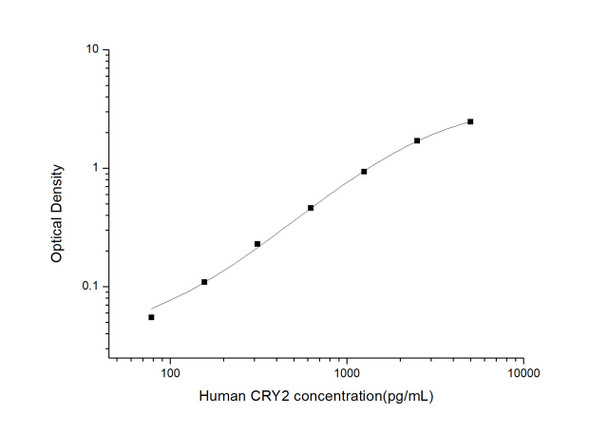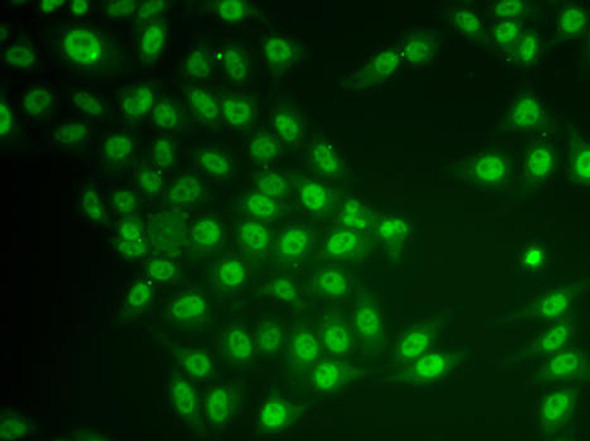Description
Human CRY2 (Cryptochrome 2) ELISA Kit
The Human CRY2 (Cryptochrome 2) ELISA Kit is a reliable and sensitive assay designed for the accurate detection of Cry2 levels in human samples such as serum, plasma, and cell culture supernatants. Cry2 is a key protein involved in the regulation of circadian rhythms, acting as a core component of the biological clock. This ELISA kit offers high specificity and sensitivity, providing researchers with dependable and consistent results for a variety of research applications.
Cry2 has been linked to various health conditions, including sleep disorders, mood disorders, and metabolic diseases, making it a valuable biomarker for studying these conditions and potential therapeutic interventions. Overall, the Human CRY2 ELISA Kit is a valuable tool for researchers interested in understanding the role of Cry2 in circadian biology and its implications for human health.
| Assay type: | Sandwich |
| Format: | 96T |
| Assay time: | 4.5h |
| Reactivity: | Human |
| Detection Method: | Colormetric |
| Detection Range: | 78.13-5000 pg/mL |
| Sensitivity: | 46.88 pg/mL |
| Sample Volume Required Per Well: | 100µL |
| Sample Type: | Serum, plasma and other biological fluids |
| Specificity: | This kit recognizes Human CRY2 in samples. No significant cross-reactivity or interference between Human CRY2 and analogues was observed. |
This ELISA kit uses Sandwich-ELISA as the method. The micro ELISA plate provided in this kit has been pre-coated with an antibody specific to Human CRY2. Standards or samples are added to the appropriate micro ELISA plate wells and combined with the specific antibody. Then a biotinylated detection antibody specific for Human CRY2 and Avidin-Horseradish Peroxidase (HRP) conjugate are added to each micro plate well successively and incubated. Free components are washed away. The substrate solution is added to each well. Only those wells that contain Human CRY2, biotinylated detection antibody and Avidin-HRP conjugate will appear blue in color. The enzyme-substrate reaction is terminated by adding Stop Solution and the color turns yellow. The optical density (OD) is measured spectrophotometrically at a wavelength of 450 nm ± 2 nm. The OD value is proportional to the concentration of Human CRY2. The concentration of Human CRY2 in samples can be calculated by comparing the OD of the samples to the standard curve.
| UniProt Protein Function: | CRY2: Blue light-dependent regulator of the circadian feedback loop. Inhibits CLOCK|NPAS2-ARNTL E box-mediated transcription. Acts, in conjunction with CRY2, in maintaining period length and circadian rhythmicity. Has no photolyase activity. Capable of translocating circadian clock core proteins such as PER proteins to the nucleus. May inhibit CLOCK|NPAS2-ARNTL transcriptional activity through stabilizing the unphosphorylated form of ARNTL. Belongs to the DNA photolyase class-1 family. 2 isoforms of the human protein are produced by alternative splicing. |
| UniProt Protein Details: | Protein type:DNA-binding; Lyase Chromosomal Location of Human Ortholog: 11p11. 2 Cellular Component: cytoplasm; extracellular region; nucleus Molecular Function:ubiquitin binding; protein binding; DNA binding; DNA (6-4) photolyase activity; damaged DNA binding; deoxyribodipyrimidine photo-lyase activity; blue light photoreceptor activity; single-stranded DNA binding; phosphatase binding Biological Process: circadian rhythm; photoreactive repair; transcription, DNA-dependent; negative regulation of transcription from RNA polymerase II promoter; glucose homeostasis; regulation of circadian rhythm; protein-chromophore linkage; entrainment of circadian clock by photoperiod; blue light signaling pathway; negative regulation of phosphoprotein phosphatase activity; negative regulation of circadian rhythm; circadian regulation of gene expression; negative regulation of transcription, DNA-dependent |
| NCBI Summary: | This gene encodes a flavin adenine dinucleotide-binding protein that is a key component of the circadian core oscillator complex, which regulates the circadian clock. This gene is upregulated by CLOCK/ARNTL heterodimers but then represses this upregulation in a feedback loop using PER/CRY heterodimers to interact with CLOCK/ARNTL. Polymorphisms in this gene have been associated with altered sleep patterns. The encoded protein is widely conserved across plants and animals. Two transcript variants encoding different isoforms have been found for this gene. [provided by RefSeq, Feb 2014] |
| UniProt Code: | Q49AN0 |
| NCBI GenInfo Identifier: | 118572252 |
| NCBI Gene ID: | 1408 |
| NCBI Accession: | Q49AN0. 2 |
| UniProt Secondary Accession: | Q49AN0,O75148, Q8IV71, B4DH32, B4DZD6, |
| UniProt Related Accession: | Q49AN0 |
| Molecular Weight: | |
| NCBI Full Name: | Cryptochrome-2 |
| NCBI Synonym Full Names: | cryptochrome circadian clock 2 |
| NCBI Official Symbol: | CRY2 |
| NCBI Official Synonym Symbols: | HCRY2; PHLL2 |
| NCBI Protein Information: | cryptochrome-2; growth-inhibiting protein 37; cryptochrome 2 (photolyase-like) |
| UniProt Protein Name: | Cryptochrome-2 |
| Protein Family: | Cryptochrome |
| UniProt Gene Name: | CRY2 |
| UniProt Entry Name: | CRY2_HUMAN |
As the OD values of the standard curve may vary according to the conditions of the actual assay performance (e. g. operator, pipetting technique, washing technique or temperature effects), the operator should establish a standard curve for each test. Typical standard curve and data is provided below for reference only.
| Concentration (pg/mL) | O.D | Average | Corrected |
| 5000 | 2.508 2.542 | 2.525 | 2.46 |
| 2500 | 1.735 1.793 | 1.764 | 1.699 |
| 1250 | 1.009 0.983 | 0.996 | 0.931 |
| 625 | 0.514 0.538 | 0.526 | 0.461 |
| 312.5 | 0.299 0.289 | 0.294 | 0.229 |
| 156.25 | 0.179 0.169 | 0.174 | 0.109 |
| 78.13 | 0.113 0.127 | 0.12 | 0.055 |
| 0 | 0.063 0.067 | 0.065 | -- |
Precision
Intra-assay Precision (Precision within an assay): 3 samples with low, mid range and high level Human CRY2 were tested 20 times on one plate, respectively.
Inter-assay Precision (Precision between assays): 3 samples with low, mid range and high level Human CRY2 were tested on 3 different plates, 20 replicates in each plate.
| Intra-assay Precision | Inter-assay Precision | |||||
| Sample | 1 | 2 | 3 | 1 | 2 | 3 |
| n | 20 | 20 | 20 | 20 | 20 | 20 |
| Mean (pg/mL) | 230.86 | 514.75 | 1755.16 | 251.21 | 565.55 | 1630.59 |
| Standard deviation | 15.12 | 25.84 | 71.61 | 13.06 | 30.48 | 54.46 |
| C V (%) | 6.55 | 5.02 | 4.08 | 5.20 | 5.39 | 3.34 |
Recovery
The recovery of Human CRY2 spiked at three different levels in samples throughout the range of the assay was evaluated in various matrices.
| Sample Type | Range (%) | Average Recovery (%) |
| Serum (n=5) | 89-99 | 94 |
| EDTA plasma (n=5) | 91-102 | 96 |
| Cell culture media (n=5) | 89-104 | 96 |
Linearity
Samples were spiked with high concentrations of Human CRY2 and diluted with Reference Standard & Sample Diluent to produce samples with values within the range of the assay.
| Serum (n=5) | EDTA plasma (n=5) | Cell culture media (n=5) | ||
| 1:2 | Range (%) | 96-111 | 96-111 | 86-102 |
| Average (%) | 103 | 102 | 93 | |
| 1:4 | Range (%) | 95-108 | 86-99 | 89-101 |
| Average (%) | 100 | 91 | 94 | |
| 1:8 | Range (%) | 89-101 | 82-94 | 89-101 |
| Average (%) | 96 | 87 | 94 | |
| 1:16 | Range (%) | 88-102 | 81-93 | 84-97 |
| Average (%) | 93 | 86 | 89 |
An unopened kit can be stored at 4°C for 1 month. If the kit is not used within 1 month, store the items separately according to the following conditions once the kit is received.
| Item | Specifications | Storage |
| Micro ELISA Plate(Dismountable) | 8 wells ×12 strips | -20°C, 6 months |
| Reference Standard | 2 vials | |
| Concentrated Biotinylated Detection Ab (100×) | 1 vial, 120 µL | |
| Concentrated HRP Conjugate (100×) | 1 vial, 120 µL | -20°C(shading light), 6 months |
| Reference Standard & Sample Diluent | 1 vial, 20 mL | 4°C, 6 months |
| Biotinylated Detection Ab Diluent | 1 vial, 14 mL | |
| HRP Conjugate Diluent | 1 vial, 14 mL | |
| Concentrated Wash Buffer (25×) | 1 vial, 30 mL | |
| Substrate Reagent | 1 vial, 10 mL | 4°C(shading light) |
| Stop Solution | 1 vial, 10 mL | 4°C |
| Plate Sealer | 5 pieces | |
| Product Description | 1 copy | |
| Certificate of Analysis | 1 copy |
- Set standard, test sample and control (zero) wells on the pre-coated plate and record theirpositions. It is recommended to measure each standard and sample in duplicate. Note: addall solutions to the bottom of the plate wells while avoiding contact with the well walls. Ensuresolutions do not foam when adding to the wells.
- Aliquot 100µl of standard solutions into the standard wells.
- Add 100µl of Sample / Standard dilution buffer into the control (zero) well.
- Add 100µl of properly diluted sample (serum, plasma, tissue homogenates and otherbiological fluids) into test sample wells.
- Cover the plate with the sealer provided in the kit and incubate for 90 min at 37°C.
- Aspirate the liquid from each well, do not wash. Immediately add 100µL of BiotinylatedDetection Ab working solution to each well. Cover the plate with a plate seal and gently mix. Incubate for 1 hour at 37°C.
- Aspirate or decant the solution from the plate and add 350µL of wash buffer to each welland incubate for 1-2 minutes at room temperature. Aspirate the solution from each well andclap the plate on absorbent filter paper to dry. Repeat this process 3 times. Note: a microplatewasher can be used in this step and other wash steps.
- Add 100µL of HRP Conjugate working solution to each well. Cover with a plate seal andincubate for 30 min at 37°C.
- Aspirate or decant the solution from each well. Repeat the wash process for five times asconducted in step 7.
- Add 90µL of Substrate Reagent to each well. Cover with a new plate seal and incubate forapproximately 15 min at 37°C. Protect the plate from light. Note: the reaction time can beshortened or extended according to the actual color change, but not by more than 30min.
- Add 50 µL of Stop Solution to each well. Note: Adding the stop solution should be done inthe same order as the substrate solution.
- Determine the optical density (OD value) of each well immediately with a microplate readerset at 450 nm.






